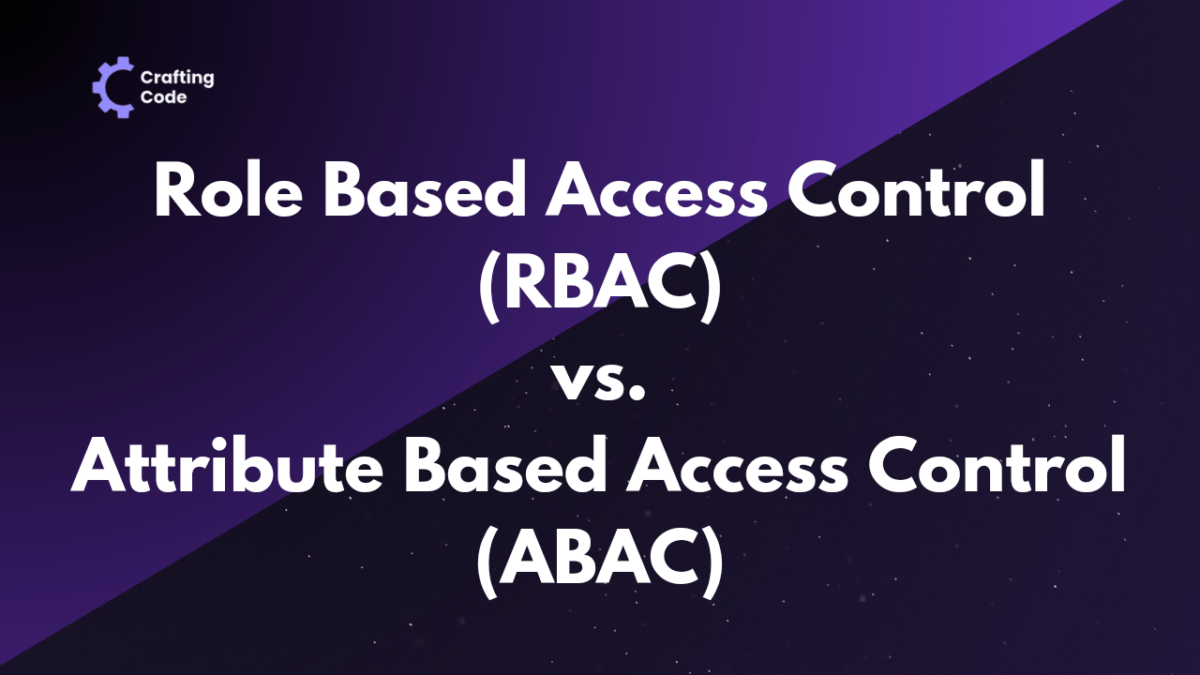Understanding the difference between Role-Based Access Control (RBAC) vs. Attribute-Based Access Control (ABAC) is important for making better decisions about access management.
The primary difference between RBAC and ABAC lies in their approaches to granting access. RBAC operates by assigning access based on predefined roles within an organization. Users are grouped into roles, and permissions are granted accordingly. On the other hand, ABAC takes a more granular approach, allowing access decisions to be based on various user characteristics, object attributes, action types, and other contextual factors.
Access control systems are security mechanisms designed to regulate and manage the access of users to resources within an organization’s network or system. These systems enforce policies and rules to ensure that only authorized users can access specific data, applications, or services, while preventing unauthorized access or misuse.
Role-Based Access Control (RBAC) is a traditional access control model that assigns permissions to users based on their roles within an organization. RBAC simplifies access management by grouping users into roles and associating permissions with these roles, making it easier to administer access rights.
Attribute-Based Access Control (ABAC), on the other hand, is a more flexible and dynamic access control model that evaluates various attributes associated with users, resources, and environmental conditions to make access decisions. ABAC allows organizations to define access policies based on attributes such as user roles, location, device type, and time of access, providing finer-grained control over access permissions.
Comparison between RBAC and ABAC
| Aspect | Role-Based Access Control (RBAC) | Attribute-Based Access Control (ABAC) |
| Granularity of Access Control | Coarse-grained, based on predefined roles. | Fine-grained, based on attributes associated with users, resources, and conditions. |
| Dynamic Access Control | Static; access permissions are typically assigned statically. | Dynamic; access control policies can adapt to changing conditions in real-time. |
| Flexibility in Access Control Policies | Limited; access control policies are tied to predefined roles. | Extensive; access control policies can be defined based on various attributes, providing greater flexibility. |
| Scalability | Suitable for medium to large-scale systems. | May require more resources for large-scale implementations, especially in environments with high volumes of attribute data. |
| Management Complexity | Relatively simple, with centralized role assignments. | Can be complex, especially in environments with multiple attribute sources, requiring careful design and configuration. |
| Integration with Existing Systems | Compatible with legacy systems that rely on role-based access control mechanisms. | May require more extensive integration efforts to ensure interoperability with existing systems, especially legacy ones. |
RBAC, a traditional access control model, organizes access permissions based on predefined roles within an organization. Users are assigned roles, and permissions are granted based on these roles. In contrast, ABAC takes a more dynamic approach, evaluating attributes associated with users, resources, and conditions to make access decisions.
RBAC offers a simplified access management system, ideal for scenarios where access control requirements are relatively straightforward. However, it’s limited by its static nature, where permissions are assigned statically and may not adapt to changing access needs over time.
ABAC, on the other hand, provides finer-grained control over access permissions by considering a broader range of attributes. This dynamic approach allows for more flexible access control policies that can adjust to evolving organizational needs and environmental conditions.
While RBAC is suitable for medium to large-scale systems, ABAC may require more resources for large-scale implementations due to its dynamic nature and evaluation of numerous attributes. Additionally, RBAC tends to be relatively simple to manage, with centralized role assignments, whereas ABAC can be more complex, especially in environments with multiple attribute sources.
Now, let’s take a closer look at these two access control models: Role-Based Access Control (RBAC) and Attribute-Based Access Control (ABAC), to explore their respective features, implementations, and use cases.
Role-Based Access Control (RBAC)
Role-Based Access Control (RBAC) is a method of access control that assigns permissions to users based on their roles within an organization. The core principle of RBAC is to simplify access management by grouping users into roles and associating permissions with these roles.
Components of RBAC:
RBAC consists of three main components:
- Roles: Roles represent job functions or responsibilities within an organization.
- Permissions: Permissions define the actions or operations that users assigned to specific roles can perform.
- Users: Users are individuals or entities who are assigned to one or more roles and granted permissions accordingly.
Advantages of RBAC:
RBAC offers several advantages:
- Simplicity in Implementation: RBAC simplifies access control by organizing permissions based on predefined roles, reducing the complexity of managing individual user permissions.
- Scalability: RBAC is highly scalable, making it suitable for organizations of varying sizes and complexities.
- Ease of Management: RBAC streamlines access management tasks, such as adding or removing user permissions, by centralizing control around role assignments.
Limitations of RBAC:
Despite its benefits, RBAC has limitations:
- Static Nature: RBAC is inherently static, meaning that changes in user roles or permissions require manual updates, which can be time-consuming and prone to errors.
- Lack of Granularity: RBAC may lack granularity in access control, as permissions are assigned at the role level rather than at the individual user level.
- Role Explosion Problem: In large organizations with diverse job roles, RBAC may lead to a proliferation of roles, resulting in complexity and difficulty in managing role assignments effectively.
Attribute-Based Access Control (ABAC)
Attribute-Based Access Control (ABAC) is an access control approach that makes authorization decisions based on attributes associated with users, resources, and environmental conditions. ABAC dynamically evaluates these attributes to determine whether access should be granted or denied.
Core Components of ABAC
ABAC comprises the following core components:
- Attributes: Attributes are characteristics or properties associated with users, resources, and environmental conditions.
- Policies: Policies define the rules or conditions under which access should be granted or denied based on attribute values.
- Subjects: Subjects are entities seeking access to resources, such as users or processes.
- Resources: Resources are the objects or data that subjects attempt to access.
Advantages of ABAC
ABAC offers several advantages:
- Fine-Grained Access Control: ABAC enables granular control over access permissions by considering a wide range of attributes, allowing organizations to define precise access rules.
- Dynamic Access Control Policies: ABAC policies can adapt to changing conditions in real-time, ensuring that access decisions remain relevant and up-to-date.
- Flexibility in Defining Access Rules: ABAC provides flexibility in defining access rules based on various attributes, enabling organizations to tailor access control policies to their specific requirements.
Limitations of ABAC
Despite its benefits, ABAC has limitations:
- Complexity in Implementation: Implementing ABAC can be complex, particularly in large and heterogeneous environments, requiring careful design and configuration.
- Potential Performance Overhead: ABAC’s dynamic nature and evaluation of numerous attributes may introduce performance overhead, especially in systems with high transaction volumes.
- Dependency on Attribute Sources: ABAC relies on accurate and reliable attribute sources to make access control decisions, making it vulnerable to inaccuracies or inconsistencies in attribute data.
Use Cases and Applications of these Access Control
Use Case Scenarios for RBAC:
- Enterprise Systems: RBAC is widely used in enterprise environments to manage access to various resources such as files, databases, and applications. By assigning roles to users based on their job functions or responsibilities, RBAC simplifies access control administration and ensures compliance with organizational policies.
- Simple Access Control Requirements: RBAC is suitable for scenarios where access control requirements are relatively straightforward and roles can be easily defined, such as small to medium-sized businesses or departments within larger organizations.
Use Case Scenarios for ABAC:
- Healthcare Systems: ABAC is well-suited for healthcare environments where access control needs to be highly granular and dynamic, considering factors such as patient confidentiality, medical specialty, and treatment protocols. ABAC allows healthcare organizations to define access policies based on attributes such as patient records, medical credentials, and time of access.
- Cloud-Based Applications: In cloud computing environments, ABAC enables organizations to enforce access control policies based on attributes such as user roles, geographic location, device type, and network security posture. ABAC provides the flexibility and scalability needed to manage access to cloud resources securely, ensuring compliance with regulatory requirements and data protection standards.
- Regulatory Compliance Requirements: ABAC can help organizations meet regulatory compliance requirements by allowing them to enforce access control policies based on specific attributes relevant to compliance standards such as GDPR, HIPAA, PCI DSS, and SOX. By dynamically evaluating attribute data, ABAC ensures that access decisions align with regulatory mandates and organizational policies.
Factors to Consider when Choosing Between RBAC and ABAC
- Organizational Requirements: Organizations should assess their access control needs, considering factors such as the level of granularity required, the dynamic nature of access control policies, and compliance obligations. RBAC may be suitable for organizations with relatively simple access control requirements, while ABAC is preferable for environments where fine-grained, dynamic access control is necessary.
- System Complexity: The complexity of the organization’s IT infrastructure and the diversity of access control requirements influence the choice between RBAC and ABAC. RBAC may be more straightforward to implement in systems with fewer users and resources, while ABAC offers greater flexibility in managing access in complex, heterogeneous environments.
- Resource Constraints: Organizations need to evaluate their available resources, including budget, personnel, and technological capabilities, when deciding between RBAC and ABAC. RBAC typically requires fewer resources for implementation and maintenance, making it a cost-effective option for organizations with limited resources.
We provide insightful content and resources to empower developers on their coding journey. If you found this content helpful, be sure to explore more of our materials for in-depth insights into various Programming Concepts.
Stay tuned for future articles and tutorials that illustrate complex topics, helping you become a more proficient and confident developer.




